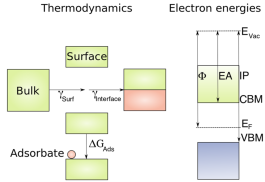Abstract
Materials for energy-related applications, which are crucial for a sustainable energy economy, rely on combining materials that form complex heterogenous interfaces. Simultaneously, progress in computational materials science in describing complex interfaces is critical for improving the understanding and performance of energy materials. Hence, we present an in-depth review of the physical quantities regulating interfaces in batteries, photovoltaics, and photocatalysts, that are accessible from modern electronic structure methods, with a focus on density functional theory calculations. For each energy application, we highlight unique approaches that have been developed to calculate interfacial properties and explore the possibility of applying some of these approaches across disciplines, leading to a unified overview of interface design. Finally, we identify a set of challenges for further improving the theoretical description of interfaces in energy devices.
